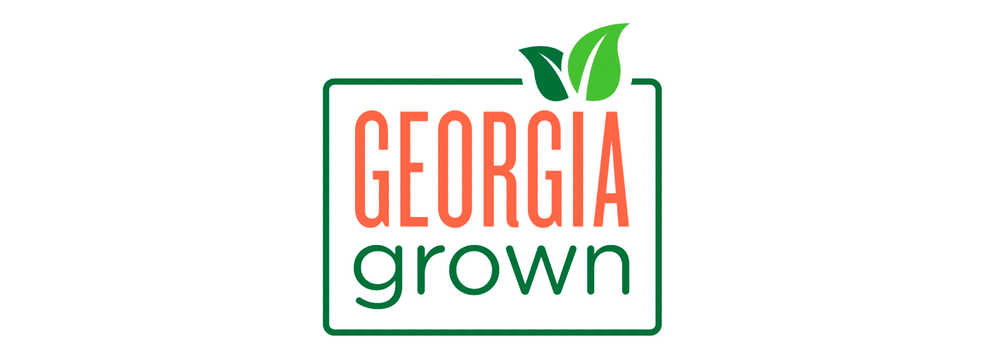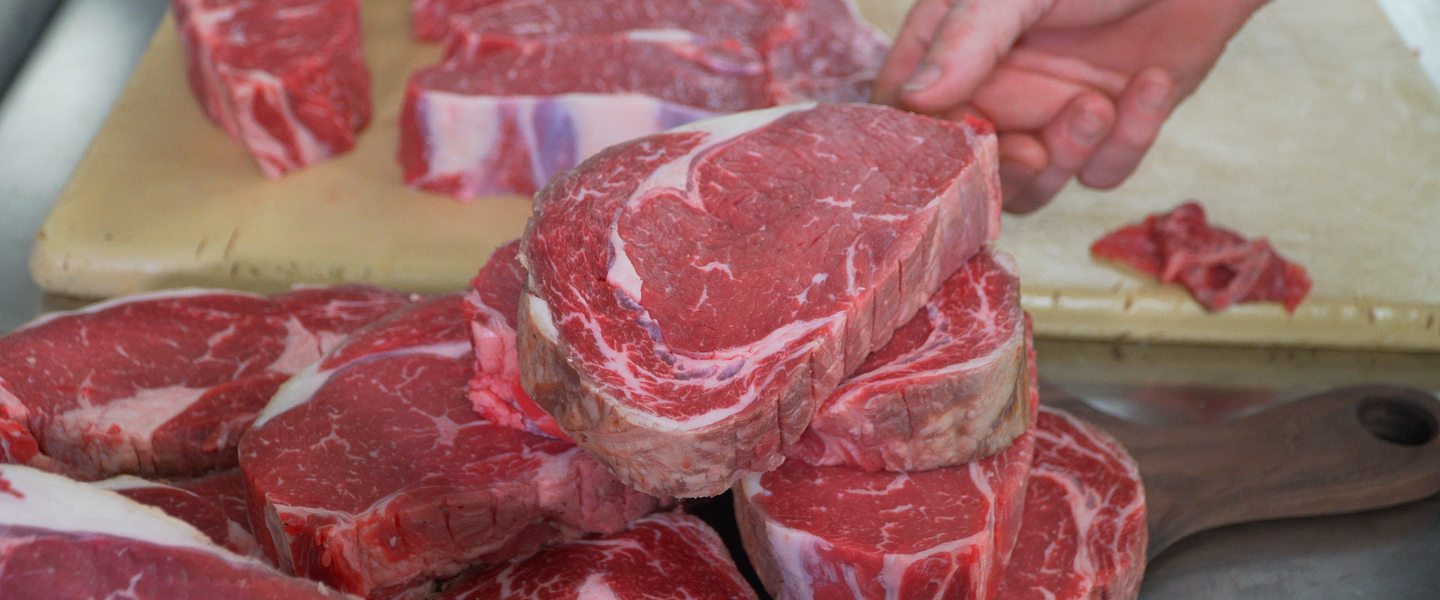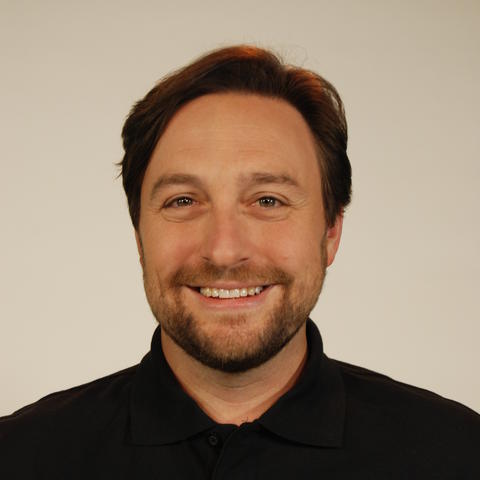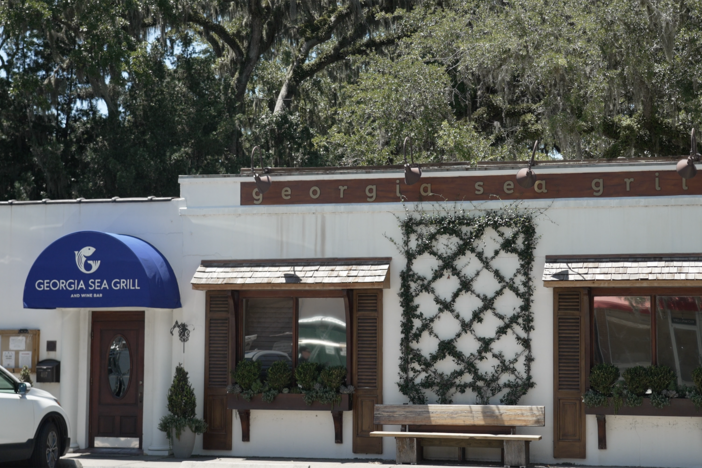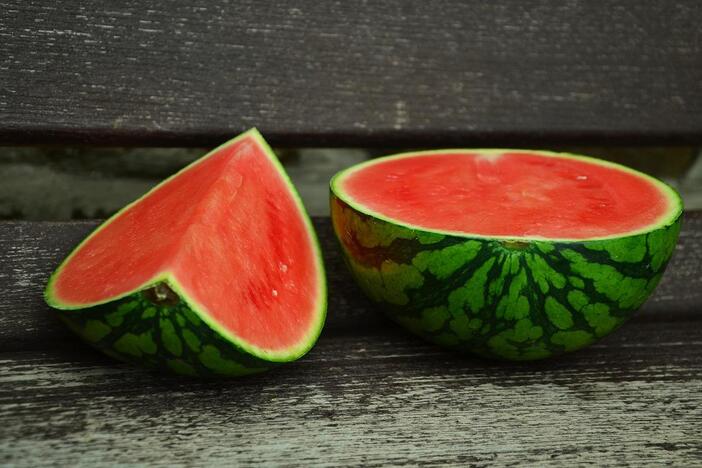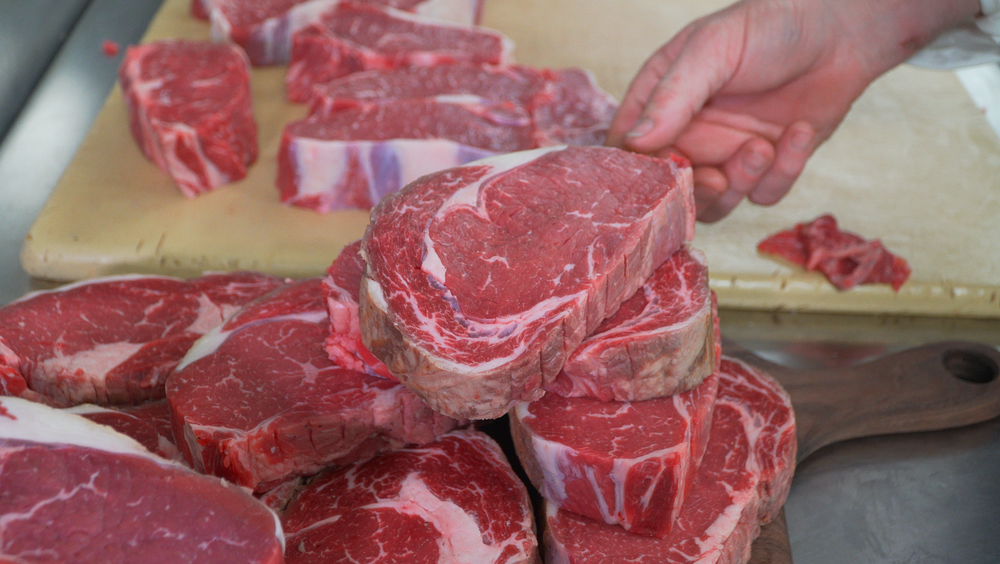
Section Branding
Header Content
A Fork in the Road Podcast: FPL Food
Primary Content
How do cattle farmers ensure their cows will produce tender and tasty beef? FPL Food in Augusta achieves it by employing a business school concept: vertical integration.

(TRANSCRIPT)
Francois Leger: How did you get tender beef? You need animals that are not stressed. That's why we are not feeding cattle with hormones. We're not using uniform. We're not using antibiotics. But we're not going to push the animals in order not to stress it. We want the animal to have a good life.
David Zelski: The average American consumes about 57 pounds of beef each year. For many of us, beef truly is what's for dinner. But do you ever stop to think about where that beef comes from, how the cows were treated and what the cows were fed? After this episode, you will.
Theme Song: I came from the mud, there's dirt on my hands. Strong like a tree, there's roots where I stand.
David Zelski: I'm David Zelski, and this is the Fork in the Road Podcast, featuring the stories from Georgia's farmers, fishermen, merchants, artisans, chefs and others who helped provide Georgia grown products to folks in the Peach State and beyond. Today, we are in Georgia's third largest city, Augusta. But we're not here to play golf or learn about James Brown. No. Today we are entering the world of FPL Food, the leading family owned producer of fresh beef in the Southeast.
Jim Rogers: You know, the agriculture industry in Georgia is strong. And, you know, we feel like we're bringing even more strength to the to the ag to the Georgia ag industry. With with with the cattle feeding business that we're doing, the support we give local farmers with with feed for our cattle that we that we feed here and in Georgia, you know, the additional farms, the genetic piece that we're bringing to the southeast and specifically into Georgia adds a lot of value to the to the Georgia ag industry. And we're we're extremely happy to be a part of it. The state of Georgia in the Agriculture Department has been extremely supportive of the things we've done over the years and we continue to do and the growth we have planned. So we're excited to be a part of it and happy to be here.
David Zelski: Now, that doesn't sound like your run of the mill cattle farm, does it? Nope. And as Jim Rogers, president of FPL Food alluded to, they do a whole lot more than just own some cows and send them off to be processed into beef. The business school word for this is vertical integration.
Jim Rogers: The vertical integration is important because you control you control everything about it, right? You control from the genetics, selecting the right cows and bulls to to provide calves for the program through the feeding, the raising, growing the crops, the, you know, to feed the cattle, the processing facilities all the way through to finish, cut steaks that show up in a in a Publix grocery store. Right. I mean, we control it all from from from the idea all the way to the finished product.
David Zelski: It takes a lot of people and a lot of care to raise, feed and process beef with control over the entire workflow. And in FPL food, it all starts at the top with the founder, Francois Leger.
Francois Leger: I have a passion for the meat business.
David Zelski: Raised on a farm in France, Francois has worked in the beef industry for almost 40 years, not just as a farmer in France, but also in Australia, South America, and now here in Georgia.
Francois Leger: And we initially we were just a cow and bull business, so not very much oriented toward high quality, but more toward ground beef. And I saw an opportunity to feed cattle in the southeast, especially with the heat and the rain we have here. And Georgia, in my opinion, is very friendly to agriculture. For us in the Southeast, if we wanted to build a high quality program, in terms of beef, there was not another way but doing it ourselves. Because everything that I've heard so far in the country was it's impossible to feed cattle in the southeast. And so we had to prove that it is possible to feed cattle in the southeast.
David Zelski: And Francois has proven that over and over again. What proof? I ask the general manager, Colin, about the number of cows on this farm.
Colin Mathews: All the feed, the cows or the car. Is that all the cattle that are in the feed yard? There's 10,800, I believe.
David Zelski: 10,800 total cattle here?
Colin Mathews: Well see total, It would be if your counting mama cows, which brings it all the way up to 11 plus 11,000 plus.
David Zelski: say that kind of in a soundbite.
Colin Mathews: Total head on this facility count in the mama cows is 11,500.
Francois Leger: When a consumer buy a piece of meat or he buys a ribeye, a tenderloin or a strip or whatever piece of meat he wants two things. He wants it to be tender and he wants it to be flavorful. And that's what we're looking for. And how do you get tender beef? You need animals that are not stressed, that's why we are not feeding cattle with hormones or added hormones. We're not using uniform, we're not using antibiotics. And if an animal gets sick, we will treat the animal. We will give him antibiotics. But we're going to separate this animal. We're going to continue to feed it, but it's going to be a different network. 90% of the animals that are fed here zero, no one wants antibiotics. We do not push them too hard in in their daily ration. And and we try to be a non stress environment for them. And I think we're quite successful at that. And this has a lot of influence on the tenderness of the meat.
David Zelski: A low stress environment and controlling the cattle intake. That is how FPL food produces high quality meat. Let's go back to Jim real quick. What about working with Francois? His vision?
Jim Rogers: Well, you know, and that's one of them. I'm relatively new with that. A little over a year now. But that's what brought me to FPL, was the vision of building this vertically integrated, sustainable beef program that that really no one else in the Southeast can do or is doing. And really, I've been around a number of places, and you don't see it anywhere really in the United States from this scale, at this level of what Francois is building here.
Francois Leger: In my opinion, sustainability is good agricultural practices. What does it mean? It means that what you take to the land you bring back to the land. That's what it means. You leave. Basically the philosophy is we come. We find a place. When we leave, we leave the place the way we found it or in better shape, because we choose to have barns and we choose also to have cattle on dry bed pack. We produce a lot of manure. And so we've hired an environmental company to help us to calculate what on your base, what we take out from the land and what we need to bring back. But bringing back, it's not only bringing fertilizers, Rosaria. The real deal is you need to bring the organic matter. You need to bring back the organic matter is that you're going to take out of the land. And so here. How do we do that? We spread every three times a year. We spread a lot of manure on our land, which has allowed us, you know, after three years we've been doing this, we've been able to measure that our production of corn per acre in silage has increased by five ton per acre.
David Zelski: Sustainability. Good agricultural practices. FPL is growing the corn, feeding the cows and returning nutrients to the soil by way of the manure. Remember that business school word. Say it with me. Vertical integration.
Colin Mathews: So this is our bed pack here that we take out of the barns and we win Rover. And we have a machine over there hooked to that tractor, and it'll turn that wind roll. So we turn that wind roll every other day and the compost, the manure breaks down into compost and then we're added up. We end up with this real, real dense product which is here on our last wind roll, and we'll apply it out to the land and basically put the nutrients back into the land. And in order to help us grow more fertile crop of corn silage.
Jim Rogers: If we didn't have this land, and if we didn't take care of this land, we wouldn't be here very long. Right. So, so being good stewards of the land and good stewards with our of our neighbors and making sure where we're doing things properly, environmentally and controlling, you know, runoff, for example, the runoff from from our operations here with the cattle is controlled. You know, any any kind of runoff goes into retention ponds where it's held and the solids naturally separate from the fluids and and don't end up in, you know, local streams or or waterways. So that's important to us. We need to be good stewards of of our land, our neighbors, our cattle and and our people and everything that that goes into making our business what it is. And without that, you know, we're not going to be around long. So so we have to we have to maintain, you know, the proper standards and do what were supposed to do.
David Zelski: Yeah. So a lot of corn.
Colin Mathews: Yeah. So this is our second crop of corn silage for the year we plant and we're roughly about 220 acres here at the farm. And we cut all this for corn silage, it's forage for our, for all the cattle on the farm and we do two crops a year of this and it takes about, oh, about 110 days for the crop to be complete.
David Zelski: FPL Food does have to buy some of the corn, they feed the cattle. But again, sustainability is the name of the game.
Francois Leger: So one thing that is very important about the feed that we give to our animals, we grow minimum 50% of the feed that we are giving to our cattle here. So our feeding capacity here Black Angus is 15,000 heads annually and we feed we grow 50% of the feed that they're going to eat on that farm and the rest we're going to buy hay from the outside and we're going to buy corn, corn grain and that we're going to flake and we are the to our knowledge, we are the only corn flaker East Mississippi and definitively the only the only feedlot of this kind in the southeast.
David Zelski: All right. Now let me explain, Corn flaker. Okay. This doesn't mean corn flakes, like at the grocery store. So let me share some scientific details with you for a second. Steam flaking is the process of adding increased moisture and heat over time to soft in the grain. Steam flaking increases the surface area of the grain, it improves starch digestibility and ultimately enhances ruminant performance. In turn, this results in improved growth performance in cattle. And no, I didn't know that off the top of my head, I am reading this off a script.
Francois Leger: So there's a reason why we we have a conflict here. It's to eliminate waste. And we if you feed corn directly to an animal, its going to reject part of it. When you feed corn flakes, you're improves your assimilation of the energy. And so the cattle will digest it better and will digest 100% of it. And you're not going to waste, we saved 20% corn like that in volume. And that's why we use a corn flaker. We cattle feeding. We want we have we do not want to overfeed the cattle. We do not want to push them hard. We want to have daily gain around 2.5, 2.7, around the life of the animal. But we're not going to push the animal in order not to stress it. We want the animal to be to have a good life. And that's number one. Number two, we're trying to control our feed and also control the quality of the feed that what we buy. As we grow 50% of it and we grow all our silage, we're able to control that quality. Then we we do not want to waste the feed. And that's why a corn flaker is a good practice. And also we use other, you know, products that we buy. Sometimes we buy, you know, peanut whole or jean trash or whatever is available in the area, you know, and that we can add to the ration.
Colin Mathews: So basically, we've got all these bags which we store commodities. We got the stellar grains we got here. We got flake corn, we got silage. We add all these ingredients into our backdrop, which incorporates them all to gravel, comes out on the conveyor into the feed truck. Feed truck delivers it to the cattle.
David Zelski: Tell me what room we're in and why it's important.
Colin Mathews: So this is a micros room. This is where we mix all our micro minerals for each batch of feed that we feed to our cattle. And this is highly important because it's minerals and we feed the precise amount of minerals to each group of cattle on a daily basis. Also, here on this computer, we're able to track all our feed usages and we're able to see any discrepancies and correct any discrepancies.
David Zelski: Yep. There's a whole lot of science involved in making sure this cattle can be turned into tender and tasty steaks. Now, let's talk to Elizabeth.
Elizabeth Caskey: So I work with the procurement of the feeder cattle into the feed yard and making sure that we have all of the right genetics coming in. The head counts are correct. The condition of the cattle, they're healthy and sound when they come off a truck, as well as following up with all of the correct paperwork to ensure the cattle are all natural. So affidavits and health certificates and transport paperwork.
David Zelski: Okay. When we say natural, when it comes to cattle, explain what makes it natural.
Elizabeth Caskey: So our definition of all natural is the cattle have never received antibiotics in their lifetimes, have never had growth implants or other added hormones, have never been fed ionophores or other animal byproducts or feed additives.
David Zelski: That's fascinating. Yeah, I think a lot of people don't understand all that goes into, you know, they see the cattle out there and figured they're just eating the grass, but there's a lot more that goes into it. You know, what is how important is that, you know, taking care of these these cattle? How important is the the care? And every day watching over them to the final product that you get.
Elizabeth Caskey: The care is our utmost number one important thing that we take care of every day. So we have about 4 to 5 pin writers is what we call them. And they spend all day, every day on horseback, in vehicles, checking fences, checking water troughs and and looking after the cattle. So what we do is we place zones is how I'll call it. So every pin writer has their own zone, so they have their certain pins that they are responsible for every day and they go check those cattle twice a day. If the water trough is leaking, they fix it. If an animal is sick, we treat an animal on a case by case basis and then we record that on paper and we record it in our computer system because every animal has an electronic ID tag in its ear. And when we process them, they run through that ID reader and we have a light that's green or red and it'll flash at us. So if it's green, the animal has never been treated. And if it flashes red, we know it's been treated. And we sought that animal separately because they have received antibiotics in their lifetime and cannot go for our all natural cattle, but we can market them a different way.
Colin Mathews: So we start at 630 in the morning and we we call feed for the morning feeding and we go around every pin and check, make sure they've got feed and water, make sure they're fed appropriate, whether they're going to need more or going to need less for a day. And then we go to them the feed mill and make sure everything's up and running over there. We make feed on a daily basis. We flick on on a daily basis. After that then we go through each individual pin, check all the animals in the in the pin and make sure they're all healthy. No sickness, if any sickness. They're treated accordingly. Then we've processed cattle that have come in from various parts of the United States. Have we received any and walked through them, identify them and put them into according place. And then early afternoon we get to do it all again, basically call feeding and make sure all the cattle have access to fresh feed and water and then feed them again for the the afternoon feeding. And that's enough to sustain them till the full amount.
David Zelski: There is a lot of work, care and science involved in the process here at FPL Food and this all culminates in the kitchen.
Todd Schafer: My name is Todd Schaefer, my restaurant Able Brown here in Augusta, Georgia. We've been open since 2014. So the reason why I use this its nastolgic, its I think it's really how beef used to be raised. Now, you know, feedlots produce the companies produce cattle that the rib eyes are 12 to £15, minimum for rib eyes. And so it makes the eye, which is here so much bigger. So it's impossible to cut a fat steak without it being, you know, 30 ounces. So I think this is, you know, as steaks have gotten bigger, it's been harder to set, harder to cut rib eyes. But now these are grown more, I guess, kind of old school. They're not they're not force fed with tons and tons of antibiotics or chemicals or anything like. That they're just very naturally raised, and so they're more in line with what I would want to use. Plus, the marbling is great. Let's say you went to a big box store to get a New York strip. It might be this wide. And so because it's so much bigger, you know, they generally a whole New York strip from a major producer weighs £14. This weighed nine. And so it's it's got all the marbling, but the flavor is much more I don't want to say condensed, but definitely much more robust. I don't know what the word. It's just they're more delicious, I think, because you can tell also that they're raised with care. You know, there's not they're not forced or anything. They just kind of are naturally raised. And this is what cattle used to look like 20 years ago.
David Zelski: I'm going to trust the professional chef knows what he's talking about because these steaks look amazing.
Todd Schafer: Again, I can't say enough about a steak that's that big because that's about, you know, I'm not kidding this is a rib eye from the seventies. This is what they used to look like. And now, I mean, they're this big, you know what I mean? They're huge. So I think this is it allows us to give a better quality piece of beef. And really, even though it is it's not packaged, it's a better package. You know, it just it's concise, its tight. It's great. I don't know what else to say.
David Zelski: There is really nothing else to say, Todd. For high quality meat. Every single detail has to be just right. The feed, the care, the land, the people, and the passion. If you enjoyed this episode on FPL food in Augusta, there's plenty more content just like it. You can watch A Fork In The Road on GPB-TV or any time on the GPB.org website. That's where you'll also be able to listen and subscribe to this podcast or download it on your favorite podcast platform. I'm David Zelski. Thanks for listening to A Fork in the Road.
This podcast is made possible in part by Georgia Grown
The A Fork in the Road TV show airs Saturdays at noon and Sundays at 6:30 a.m. on GPB-TV. Check your local listings for other replays throughout the week and watch all episodes anytime at GPB.org/ForkintheRoad. Please download and subscribe to the Fork in the Road podcast at GPB.org/ForkintheRoadpodcast or on your favorite podcast platform as well.
